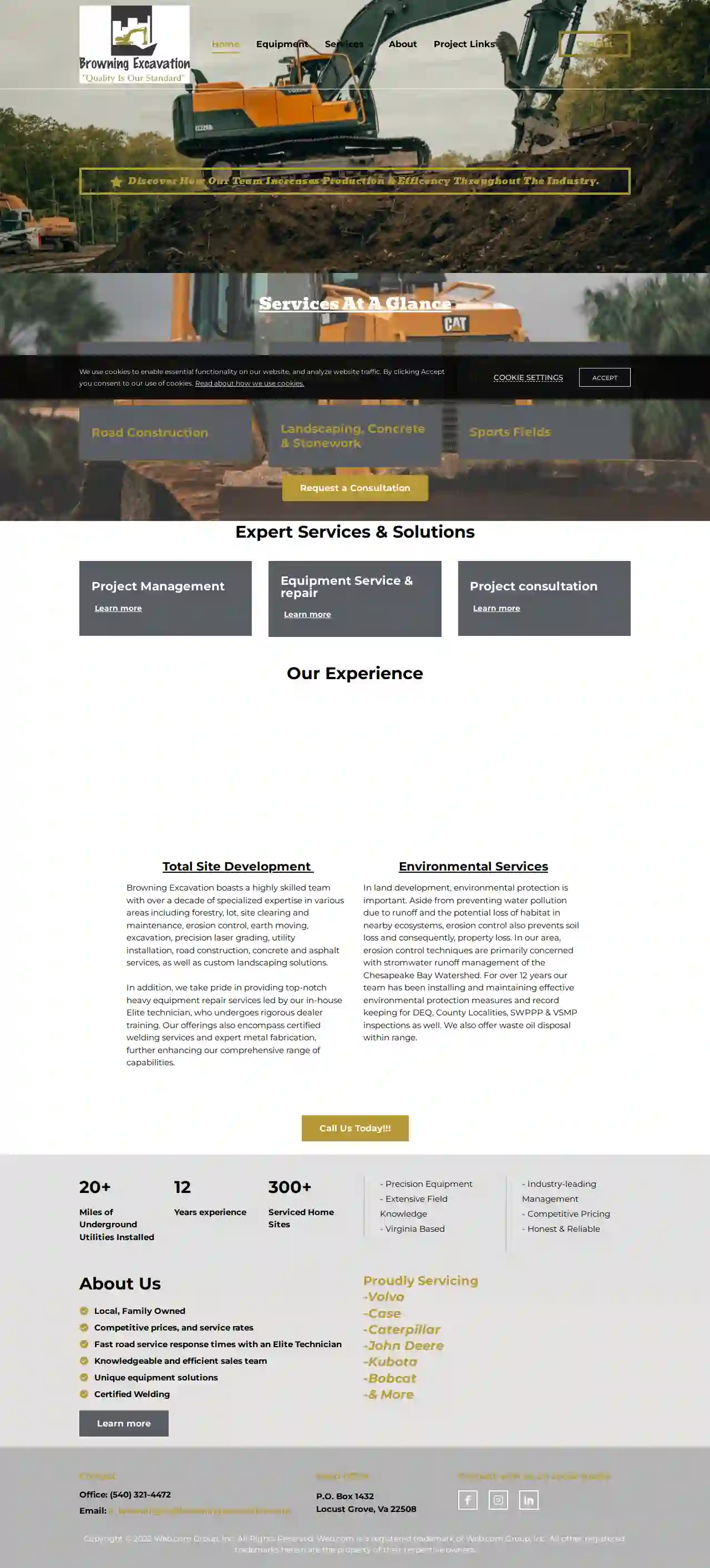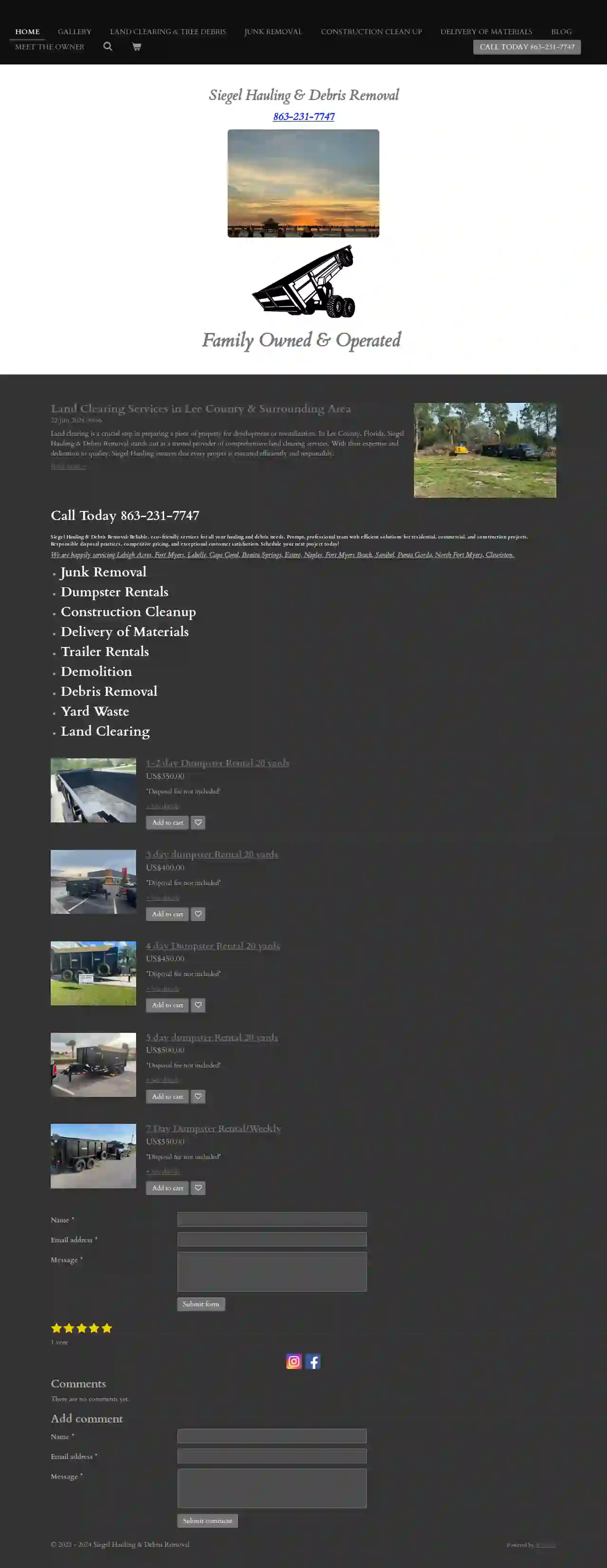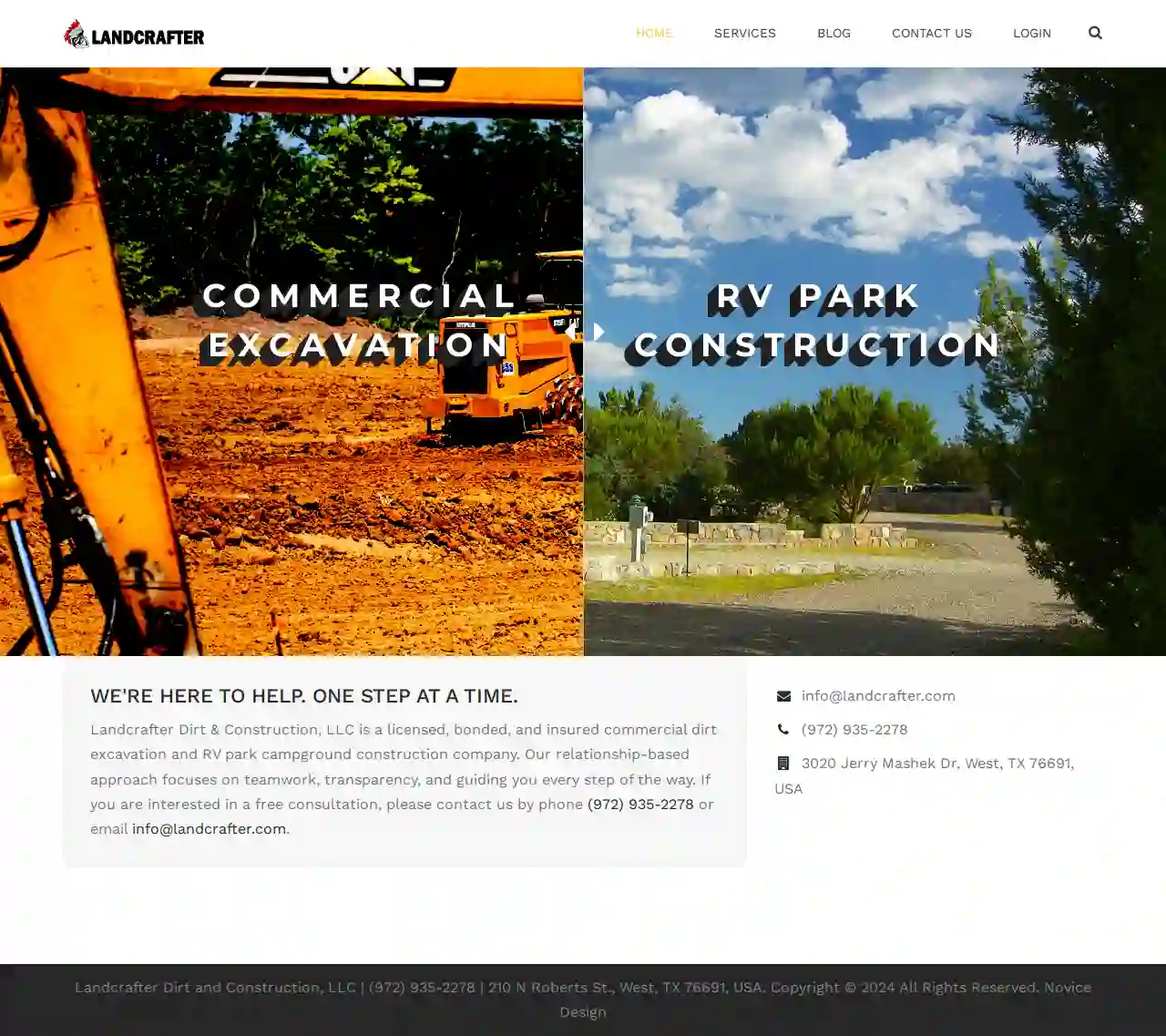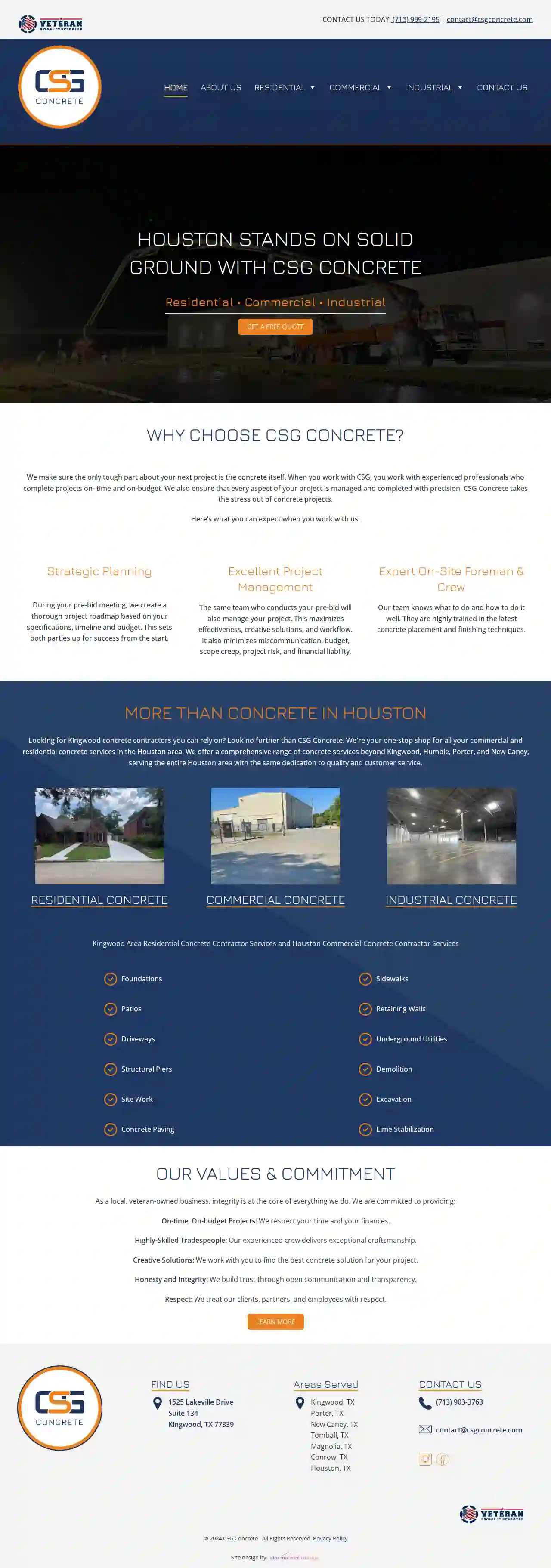Demolition Contractors Pinehurst
Find top Demolition Services in Pinehurst
Get multiple Demolition Contractors Near Me quotes for your project today! Compare profiles, reviews, accreditations, portfolio, etc... and choose the best offer.

Rayco Excavation & Construction
52 reviewsCaddo Mills, USAbout Rayco Excavation & Construction Rayco Excavation & Construction is a professional & experienced land clearing & construction company that is located in Caddo Mills, TX. We provide our clients with a wide range of services including, but not limited to: excavation, land clearing, general construction, grading, site prep & more. Our company works with commercial, residential, & government clients, providing quality services and premier customer service on every project. To learn more about what Rayco Excavation & Construction has to offer, please select from one of the following options: (214) 708-1206 Request a Free Quote
- Services
- Why Us?
- Gallery
Get Quote
Upstream Environmental LLC
51 reviews9595 Six Pines Bldg 8 Suite 8210, The Woodlands, 77380, USUpstream Environmental LLC Upstream Environmental LLC specializes in post construction storm water quality management & permitting services in the City of Houston & Harris Counties unincorporated areas. We provide turnkey regulatory compliance to developers, commercial and residential property owners, general contractors, homeowner associations and municipal utility districts. Upstream Environmental LLC is a professional storm water post construction management company, and is partnered with a registered engineering firm in the State of Texas. Upstream Environmental is owned and operated in the State of Texas and takes pride in building a long and special relationship with our clients, providing a source of expertise and the ability to perform maintenance required to keep them in regulatory compliance with The City of Houston, Harris County & Texas Commission on Environmental Quality. Our inspectors, and the BMP installers have attended training programs, including seminars, trade shows, site inspections, testing, and regulatory audits, to become familiar with local, state, and federal requirements.
- Services
- Why Us?
- Gallery
Get Quote
Blue Moon Hauling
4.79 reviews13402 North Virginia Avenue, Smithville, 64089, USBlue Moon Hauling & Excavation: Your Trusted Partner for Site Work Centrally located in Smithville, Missouri, Blue Moon Hauling and Excavation LLC has been providing competitively priced, professional, and timely service to our clients and construction partners for over two decades. We're experts in excavation and hauling, and our knowledge can make the difference between a successful project and a costly one. We're fully bonded and licensed, and our goal is to keep your project moving efficiently with quality, safety, and the bottom line in mind. Meet Joel Krull, Owner and Founder Joel Krull, the owner and founder of Blue Moon Hauling, brings over 12 years of experience as a Field Superintendent on large commercial projects to the table. He's a member of the Kansas City Builders' Association, has completed the Army Corp of Engineers Supervisory Training Program, and is certified by the U.S. Army Corp of Engineers as a Quality Construction Manager. Blue Moon Hauling has been in business since 1998, starting as a trucking company and expanding to encompass all aspects of site work. We perform building demolition, site demolition, clearing & grubbing, mass excavation, grading, site water utilities, site storm utilities, and site sanitary utilities. We work with both the commercial and municipality sectors, contracting as both a general contractor and a sub-contractor. Our team of operators, laborers, and office staff are dedicated to delivering quality, safety, and efficiency on every project.
- Services
- Why Us?
- Gallery
Get Quote
GTex General Contracting
526 reviews10903 Gabriel's Place, San Antonio, 78217, USGTex General Contracting: Transforming Dreams into Reality With over 20 years of experience in residential and commercial general contracting, GTex General Contracting is dedicated to providing outstanding customer service and unparalleled workmanship on every project. We are accredited with the BBB, bonded, and insured, and we never ask for money upfront. Our team is committed to meeting deadlines, staying within your budget, and ensuring clear communication throughout the entire process. We combine our industry knowledge, the highest quality building supplies and equipment, and our dedication to deliver exceptional service to our clients. Your satisfaction is our utmost priority. GTex has proudly served hundreds of Residential and Commercial General Contracting jobs. Meet Ryan Gabriel, Owner: Born and raised in San Antonio, Ryan has served the local Bexar County community for over 13 years as a law enforcement officer. He has always had a passion for construction, seeing it as an art form. Ryan is dedicated to providing great customer service and A+ quality work to all of Texas.
- Services
- Why Us?
- Accreditations
- Our Team
- Gallery
Get Quote
Browning Excavation
52 reviewsP.O. Box 1432, Locust Grove, 22508, USTotal Site Development Browning Excavation boasts a highly skilled team with over a decade of specialized expertise in various areas including forestry, lot, site clearing and maintenance, erosion control, earth moving, excavation, precision laser grading, utility installation, road construction, concrete and asphalt services, as well as custom landscaping solutions. Environmental Services In land development, environmental protection is important. Aside from preventing water pollution due to runoff and the potential loss of habitat in nearby ecosystems, erosion control also prevents soil loss and consequently, property loss. In our area, erosion control techniques are primarily concerned with stormwater runoff management of the Chesapeake Bay Watershed. For over 12 years our team has been installing and maintaining effective environmental protection measures and record keeping for DEQ, County Localities, SWPPP & VSMP inspections as well. We also offer waste oil disposal within range. About Us Based in Locust Grove, VA, Browning Excavation is a reputable commercial and residential contractor serving Northern and Central Virginia. With three generations of family expertise in the industry, we established Browning Excavation in 2019. Our specialized services encompass lot & site clearing, land maintenance, erosion control, earth moving, precision laser grading, utility installation, road construction, sports fields, concrete and asphalt work, landscaping, stonework, as well as heavy equipment repair provided by our in-house Elite technician and certified welding services. Our dedicated team of skilled professionals, consisting of both family and friends, utilizes a diverse range of equipment, enabling us to undertake projects of virtually any size for our clients. Quality Is Our Standard "I founded this company to provide the very best services in the industry, maximize efficiency and minimize cost to our clients."~Chris Browning President
- Services
- Why Us?
- Our Team
Get Quote
Siegel Hauling & Debris Removal
511 reviewsSpring, USSiegel Hauling & Debris Removal: Your Reliable Partner for Hauling and Debris Removal in Southwest Florida Siegel Hauling & Debris Removal is a family-owned and operated business dedicated to providing efficient and reliable hauling and debris removal services for residential, commercial, and construction projects in Southwest Florida. We are committed to responsible disposal practices, competitive pricing, and exceptional customer satisfaction. Our team of experienced professionals is equipped to handle a wide range of projects, from small cleanups to large-scale demolition and land clearing. We understand the importance of timely and professional service. That's why we strive to provide prompt and efficient solutions for all your hauling and debris needs. We are proud to serve the communities of Lehigh Acres, Fort Myers, Labelle, Cape Coral, Bonita Springs, Estero, Naples, Fort Myers Beach, Sanibel, Punta Gorda, North Fort Myers, and Clewiston. Contact us today for a free estimate and let us help you with your next project!
- Services
- Why Us?
- Gallery
Get Quote
Bicknell Excavating
53 reviewsPlano, USBicknell Excavating: A Family Legacy of Quality Bicknell Excavating is a local, family-owned and operated business run by father and sons. We are dedicated to making your project a success by exceeding expectations, valuing your time, and ensuring cost-efficiency. Our commitment to quality and customer satisfaction is deeply rooted in our family values. Taylor and Jordan Bicknell, driven by their passion for the industry, established Bicknell Excavating in 2020. Their dedication to learning the trade and honing their skills has resulted in a company that consistently delivers exceptional results. In 2021, Jordan joined Taylor in partnership, further strengthening their commitment to excellence. In 2024, their father, Kelly, retired and joined his sons in their business venture, bringing his wealth of experience in customer service, administration, and operations to the team. Together, they form a dynamic trio, combining their expertise to provide comprehensive and reliable excavation services. As resident Texans from the east Texas area, we understand the importance of delivering quality work on time. We are proud to serve our community with integrity and a commitment to exceeding expectations.
- Services
- Why Us?
- Our Team
- Testimonials
- Gallery
Get Quote
Landcrafter Dirt and Construction
51 reviews210 N Roberts St., West, 76691, USWE'RE HERE TO HELP. ONE STEP AT A TIME. Landcrafter Dirt & Construction, LLC is a licensed, bonded, and insured commercial dirt excavation and RV park campground construction company. Our relationship-based approach focuses on teamwork, transparency, and guiding you every step of the way. If you are interested in a free consultation, please contact us by phone (972) 935-2278 or email [email protected] .
- Services
- Why Us?
- Gallery
Get Quote
Texoma Excavation
51 reviews114 Highway 377 North, Whitesboro, 76273, USUnearth Your Dreams From excavation to site preparation, Texoma Excavation is here to make your vision a reality. We work with all budgets. About Texoma Excavation Our Mission At Texoma Excavation, our mission is to provide high-quality excavation services that exceed our customers’ expectations. We are committed to delivering safe, efficient, and cost-effective solutions to our clients' excavation needs. Our Experience With over 30 years of experience in the excavation industry, our team has the expertise and knowledge to handle any project, big or small. We have completed projects in a variety of industries, including commercial, residential, farm and ranch. Our Equipment We use state-of-the-art equipment and technology to ensure that our projects are completed safely and efficiently. Our fleet includes excavators, bulldozers, scrapers, skid steers and more, all maintained to the highest standards.
- Services
- Why Us?
- Gallery
Get Quote
CSG Concrete
511 reviews1525 Lakeville Drive, Suite 134, Kingwood, 77339, USHouston Stands on Solid Ground with CSG Concrete Residential • Commercial • Industrial Get a Free Quote Why Choose CSG Concrete? We make sure the only tough part about your next project is the concrete itself. When you work with CSG, you work with experienced professionals who complete projects on-time and on-budget. We also ensure that every aspect of your project is managed and completed with precision. CSG Concrete takes the stress out of concrete projects. Here’s what you can expect when you work with us: Strategic Planning During your pre-bid meeting, we create a thorough project roadmap based on your specifications, timeline and budget. This sets both parties up for success from the start. Excellent Project Management The same team who conducts your pre-bid will also manage your project. This maximizes effectiveness, creative solutions, and workflow. It also minimizes miscommunication, budget, scope creep, project risk, and financial liability. Expert On-Site Foreman & Crew Our team knows what to do and how to do it well. They are highly trained in the latest concrete placement and finishing techniques. More Than Concrete in Houston Looking for Kingwood concrete contractors you can rely on? Look no further than CSG Concrete. We're your one-stop shop for all your commercial and residential concrete services in the Houston area. We offer a comprehensive range of concrete services beyond Kingwood, Humble, Porter, and New Caney, serving the entire Houston area with the same dedication to quality and customer service. RESIDENTIAL CONCRETE COMMERCIAL CONCRETE INDUSTRIAL CONCRETE Kingwood Area Residential Concrete Contractor Services and Houston Commercial Concrete Contractor Services Foundations Patios Driveways Structural Piers Site Work Concrete Paving Sidewalks Retaining Walls Underground Utilities Demolition Excavation Lime Stabilization Our Values & Commitment As a local, veteran-owned business, integrity is at the core of everything we do. We are committed to providing: On-time, On-budget Projects: We respect your time and your finances. Highly-Skilled Tradespeople: Our experienced crew delivers exceptional craftsmanship. Creative Solutions: We work with you to find the best concrete solution for your project. Honesty and Integrity: We build trust through open communication and transparency. Respect: We treat our clients, partners, and employees with respect. Learn more
- Services
- Why Us?
- Gallery
Get Quote
Over 22,076+ Excavation Businesses on our platform
Our excavation pros operate in Pinehurst and surroundings!
ExcavationHQ has curated and vetted the Best Excavation Businesses in and around Pinehurst. Find the most reliable contractor today.
Frequently Asked Questions About Demolition Contractors
- Dust Suppression: Use water spraying, misting systems, or other dust suppression techniques to control airborne particles.
- Noise Barriers: Erect temporary noise barriers around the demolition site to reduce noise transmission to nearby properties.
- Work Schedule: Schedule noisy demolition activities during permitted hours to minimize disturbance to neighbors.
- Communication: Keep neighbors informed about the demolition schedule and any potential disruptions.
- Waste Generation: Demolition generates a large volume of debris, contributing to landfill space and potentially releasing harmful substances into the environment if not disposed of properly.
- Air Pollution: Dust and particulate matter released during demolition can impact air quality, affecting human health and the environment.
- Noise Pollution: Demolition activities can generate significant noise, disturbing nearby residents and wildlife.
- Resource Depletion: Demolition consumes resources that could be salvaged and reused, contributing to resource depletion and environmental degradation.
- Enclosure: Sealing off the asbestos-containing material to prevent fiber release.
- Encapsulation: Coating the asbestos-containing material with a sealant to bind the fibers.
- Removal: Carefully removing the asbestos-containing material and disposing of it safely.
- Permits and Regulations: Obtain all necessary demolition permits and comply with local building codes and environmental regulations.
- Contracts: Have a clear and comprehensive contract with the demolition contractor outlining the scope of work, payment terms, and liabilities.
- Environmental Laws: Comply with environmental laws regarding hazardous material removal, waste disposal, and pollution control.
- Neighboring Property Rights: Respect neighboring property rights and take measures to prevent damage or disruption to adjacent properties.
- Worker Safety: Adhere to worker safety regulations and provide a safe working environment for demolition crews.
How can I minimize the dust and noise from demolition?
What are the environmental impacts of demolition?
What are the different methods of asbestos abatement?
What are the legal considerations for demolition projects?
How can I minimize the dust and noise from demolition?
- Dust Suppression: Use water spraying, misting systems, or other dust suppression techniques to control airborne particles.
- Noise Barriers: Erect temporary noise barriers around the demolition site to reduce noise transmission to nearby properties.
- Work Schedule: Schedule noisy demolition activities during permitted hours to minimize disturbance to neighbors.
- Communication: Keep neighbors informed about the demolition schedule and any potential disruptions.
What are the environmental impacts of demolition?
- Waste Generation: Demolition generates a large volume of debris, contributing to landfill space and potentially releasing harmful substances into the environment if not disposed of properly.
- Air Pollution: Dust and particulate matter released during demolition can impact air quality, affecting human health and the environment.
- Noise Pollution: Demolition activities can generate significant noise, disturbing nearby residents and wildlife.
- Resource Depletion: Demolition consumes resources that could be salvaged and reused, contributing to resource depletion and environmental degradation.
What are the different methods of asbestos abatement?
- Enclosure: Sealing off the asbestos-containing material to prevent fiber release.
- Encapsulation: Coating the asbestos-containing material with a sealant to bind the fibers.
- Removal: Carefully removing the asbestos-containing material and disposing of it safely.
What are the legal considerations for demolition projects?
- Permits and Regulations: Obtain all necessary demolition permits and comply with local building codes and environmental regulations.
- Contracts: Have a clear and comprehensive contract with the demolition contractor outlining the scope of work, payment terms, and liabilities.
- Environmental Laws: Comply with environmental laws regarding hazardous material removal, waste disposal, and pollution control.
- Neighboring Property Rights: Respect neighboring property rights and take measures to prevent damage or disruption to adjacent properties.
- Worker Safety: Adhere to worker safety regulations and provide a safe working environment for demolition crews.